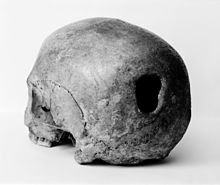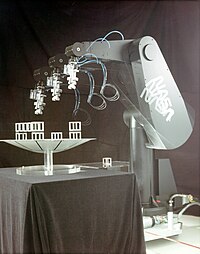User:Billynorlin/sandbox
Article Evaluation
For this assignment, I chose to look at the Wikipedia page for Ciarán of Saigir - one of the abortionist saints that we read about this past week in class. There was a surprising amount of material on this page. I think that most everything include is relevant to the life of Ciarán. However, the lack of citations in some claims was a little distracting. I think that the article is neutral: it mainly just focused on certain mundane events of his life as well as his genealogy. It does bring in his ties to St. Patrick though, which I thought was interesting. The section containing stories of the miracles he was said to have committed was pretty choppy and hard to follow. I think that these examples were underrepresented and this entire section could've been flushed out to make it clearer. Not all claims were cited. For example, the first sentence of the second paragraph of the Foundation of Saighir section has no citation whenever it includes a multitude of facts about Ciarán. The sources seem pretty balanced and unbiased. Some of the sources even come from university presses. The biggest thing I noticed about this article is that it made no mention of this saint's participation in abortion that we talked about. There are several key points in the talk page. Some have pointed out that there's an academic disagreement about the date of St. Ciarán's lifetime. The other big contribution was modifications to the citations. I didn't notice any rating on this wikipedia article or if it is part of any WikiProjects. This article seemed to mirror a lot of what we said in class concerning his lifetime. It did go into more depth about his relations with St. Patrick, but it did not talk about his role in abortion whatsoever. In class we talked about how he was involved with abortion and it was also talked about in the Maeve Callan article.
Billynorlin (talk) 00:36, 15 October 2017 (UTC)
10-14-17 My Lead Section: I think the current lead is enough to capture readers' attention without wandering, but I will add to the lead for the History subsection.
There are recorded instances of neurosurgery being practiced in ancient Germany and the Incan empire. Skulls recovered from archeological sites have shown the after-effects of these practices.
The history section totally lacks any mention of surgery in Germany as well as the evolution of neurosurgery due to research in teaching hospitals in more modern times.
Billynorlin (talk) 00:48, 15 October 2017 (UTC)
History
[edit]Neurosurgery, or the premeditated incision into the head for pain relief, has been around for thousands of years, but notable advancements in neurosurgery have only come within the last hundred years.[1]

Ancient
[edit]The Incas appear to have practiced a procedure known as trepanation since the late Stone age.[2] During the Middle Ages in Arabia from 936 to 1013 AD, Al-Zahrawi performed surgical treatments of head injuries, skull fractures, spinal injuries, hydrocephalus, subdural effusions and headache.[3]
Modern
[edit]There was not much advancement in neurosurgery until late 19th early 20th century, when electrodes were placed on the brain and superficial tumors were removed.
History of electrodes in the brain: In 1878 Richard Canton discovered that electrical signals transmitted through an animal's brain. In 1950 Dr. Jose Delgado invented the first electrode that was implanted in an animal's brain, using it to make it run and change direction. In 1972 the cochlear implant, a neurological prosthetic that allowed deaf people to hear was marketed for commercial use. In 1998 researcher Philip Kennedy implanted the first brain computer interface (BCI) into a human subject.[4]
History of tumor removal: In 1879 after locating it via neurological signs alone, Scottish surgeon William Macewen (1848–1924) performed the first successful brain tumor removal.[5] On November 25, 1884 after English physician Alexander Hughes Bennett (1848–1901) used Macewen's technique to locate it, English surgeon Rickman Godlee (1849–1925) performed the first primary brain tumor removal,[6][7] which differs from Macewen's operation in that Bennett operated on the exposed brain, whereas Macewen operated outside of the "brain proper" via trepanation.[8] On March 16, 1907 Austrian surgeon Hermann Schloffer became the first to successfully remove a pituitary tumor.[9]
Modern surgical instruments
[edit]

The main advancements in neurosurgery came about as a result of highly crafted tools. Modern neurosurgical tools, or instruments, include chisels, curettes, dissectors, distractors, elevators, forcepts, hooks, impactors, probes, suction tubes, power tools, and robots.[10][11] Most of these modern tools, like chisels, elevators, forcepts, hooks, impactors, and probes, have been in medical practice for a relatively long time. The main difference of these tools, pre and post advancement in neurosurgery, were the precision in which they were crafted. These tools are crafted with edges that are within a millimeter of desired accuracy.[12] Other tools such as hand held power saws and robots have only recently been commonly used inside of a neurological operating room.
Billynorlin (talk) 00:36, 15 October 2017 (UTC)
Neurosurgery in the Neolithic Age In 1910, Paul Berger excavated underneath a Bronze age hearth near Halle, Germany, where he unearthed human remains that showed crude surgical openings in the skull. The remains were dated to between 2700 – 2200 BCE. The skull had two trephinations and these operations were performed at different times. Trephinations are crude surgical holes made through either scraping, cutting, or drilling away the layers of bone, and great care is taken to preserve the outermost lining of the brain, the dura mater. Further analysis of the bones concluded that the areas around the holes began to heal, which suggests that this person survived for months to years after the trephinations. Researchers hypothesize that since certain regions contained more skulls with trephinations, this practice may be rooted in superstitious beliefs. Trephinations were conducted “with rudimental anesthetic, antiseptic, and technological aids.”
Alfieri, Alex, et al. "The Woman of Pritschoena: An Example of the German Neolithic Neurosurgery in Saxony-Anhalt." Journal of the History of the Neurosciences, vol. 21, no. 2, 2012, pp. 139-146. EBSCOhost, libraries.ou.edu/access.aspx?url=http://search.ebscohost.com.ezproxy.lib.ou.edu/login.aspx?direct=true&db=htm&AN=XISI1211249-H&site=ehost-live. Alfieri, Alex, Christian Strauss, Harald Meller, Bettina Stoll-Tucker, Pawel Tacik, and Silvio Brandt. 2012. "The Woman of Pritschoena: An Example of the German Neolithic Neurosurgery in Saxony-Anhalt." Journal Of The History Of The Neurosciences 21, no. 2: 139-146. History of Science, Technology & Medicine, EBSCOhost (accessed November 18, 2017).
Development in the early 1900s Looking at the structure of the skull without operating became possible with the advent of X-ray machines in 1896. Surviving records from Dr. Harvey Cushing at Johns Hopkins Hospital revealed greater care being taken in neurosurgery. During this time, surgeons did not wear gloves or masks and operated as quickly as possible. Cushing was critical of this practice and compared these operations to “the way a commercial traveler grabs breakfast at a lunch counter.” He studied how blood vessels in the brain reacted to changes in intracranial pressure by placing glass windows in the skulls of dogs. Using what he learned form these studies, he was able to perform brain tumor resections. Cushing’s efforts to combat sepsis and improve surgical techniques decreased the mortality rates for penetrating skull injuries from 54.4% to 28.8% over the course of a three-month period.
Kinsman, Michael, et al. "Harvey Cushing's Early Experience with the Surgical Treatment of Head Trauma." Journal Of The History Of The Neurosciences 22, no. 1 (2013): 96-115. History of Science, Technology & Medicine, EBSCOhost (accessed November 18, 2017). Kinsman, Michael, et al. "Harvey Cushing's Early Experience with the Surgical Treatment of Head Trauma." Journal of the History of the Neurosciences, vol. 22, no. 1, 2013, pp. 96-115. EBSCOhost, libraries.ou.edu/access.aspx?url=http://search.ebscohost.com.ezproxy.lib.ou.edu/login.aspx?direct=true&db=htm&AN=XISI1211275-H&site=ehost-live.
Billynorlin (talk) 23:22, 18 November 2017 (UTC)
- ^ Wickens, Andrew P. (2014-12-08). A History of the Brain: From Stone Age surgery to modern neuroscience. Psychology Press. ISBN 9781317744825.
- ^ Andrushko, Valerie A.; Verano, John W. (September 2008). "Prehistoric trepanation in the Cuzco region of Peru: A view into an ancient Andean practice". American Journal of Physical Anthropology. 137 (1): 4–13. doi:10.1002/ajpa.20836. PMID 18386793.
- ^ Al-Rodhan, N. R.; Fox, J. L. (1986-07-01). "Al-Zahrawi and Arabian neurosurgery, 936-1013 AD". Surgical Neurology. 26 (1): 92–95. doi:10.1016/0090-3019(86)90070-4. ISSN 0090-3019. PMID 3520907.
- ^ Cite error: The named reference
Brown BI108was invoked but never defined (see the help page). - ^ Cite error: The named reference
Preul2005was invoked but never defined (see the help page). - ^ Cite error: The named reference
pmid6387062was invoked but never defined (see the help page). - ^ "Alexander Hughes Bennett (1848-1901): Rickman John Godlee (1849-1925)". CA: A Cancer Journal for Clinicians. 24 (3): 169–170. 1974. doi:10.3322/canjclin.24.3.169.
- ^ Cite error: The named reference
uakron gage surgerywas invoked but never defined (see the help page). - ^ http://www.neurosurgery.org/cybermuseum/microneurohall/jhardy.html[full citation needed]
- ^ http://www.medicalexpo.com/medical-manufacturer/neurosurgery-surgical-power-tool-11882.html[full citation needed]
- ^ http://www.stealthsurgical.com/department/neurosurgical-10000.cfm[full citation needed]
- ^ http://news.psu.edu/story/285212/2013/08/26/impact/technology-increases-precision-safety-during-neurosurgery[full citation needed]

